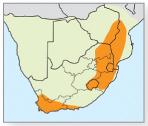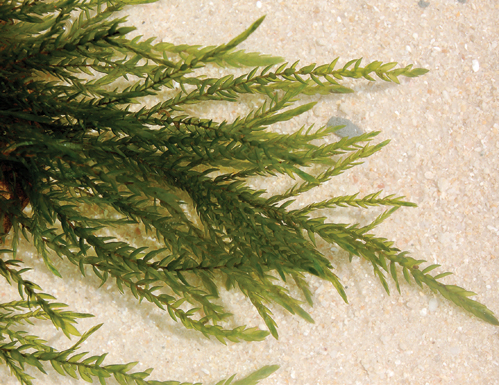
26 |
Text by Terry Hedderson |
|---|---|
The groups that comprise the ‘bryophytes’, Anthocerotophyta, Marchantiophyta and Bryophyta, are evolutionarily and morphologically distinct. Uniquely for land plants they have a dominant gametophyte generation, upon which the sporophyte is parasitic. In bryophytes the plant body corresponds to the pollen grains or ovules of flowering plants (gametophyte generation), while the sporophyte is unbranched, lacks leaves and consists only of a stalk and capsule. As in the ferns, sperm are motile, reaching the egg by swimming through a film of water. Lacks roots, but thread-like rhizoids anchor the plants and absorb water. Main groups easy to recognise in the field, but identification to genus and species requires sectioning and microscopic examination.
Dark green thalli with embedded black dots (Nostoc cyanobacteria). Cylindrical, unstalked sporophytes split at the tips to form unique curling ‘horns’. Two of the seven southern African species are common in fresh waters.
1 Smooth hornwort
Phaeoceros laevis


© C. GRIFFITHS
Large, dark green thalli with scalloped edges. Size: Thalli 1–2cm wide. Biology: Cells have a single large chloroplast containing a pyrenoid – a dense structure associated with CO2 accumulation and fixation. Invariably form symbioses with blue-greens, whose colonies form the characteristic dark dots in the thallus. Found on permanently wet rocks along streams.
Liverworts are either leafy or thalloid (body not differentiated into stems and leaves). When present, the very short-lived sporophyte, with a transparent stalk and a spherical to ellipsoidal capsule that splits into four or more valves, makes the group unmistakable. Microscopically, the oil bodies in the leaf or thallus cells are unique to this group. Approximately 390 species recorded from southern Africa, with about 40 in freshwater habitats.
2 Umbrella liverwort
Marchantia berteroana


© C. GRIFFITHS
Yellow-green to blue-green thalli, with air pores and a network of whitish lines on upper surface, and 4–6 rows of purplish ventral scales. Sexes separate. When gemmae cups or the umbrella-shaped gamete-producing structures are present, the genus is unmistakable. The three other species occurring in the northeastern parts of the region are reliably separated from M. berteroana only by microscopic characteristics. Size: Thalli 1–1.8cm in width. Biology: Perennial plants with persistent populations. Sperm is released into a splash cup formed on upper surface of the antheridiophore (the gamete-bearing structure) and dispersed considerable distances by raindrops. Form thick mats of overlapping thalli on wet rocks and soil along streams and around waterfalls.
3 Narrow crystalwort
Riccia stricta


© C. GRIFFITHS
Narrow, dichotomously branched (i.e. plant body with extensions branching into two) whitish to bright green thalli with purple or red streaks; ventrally has small, widely spaced, glassy scales. Often forms dense tangled masses. Size: Thalli 0.5–1.2mm in width. Biology: An ephemeral species appearing on soil exposed during periods of low water, surviving inundation as spores, or as asexually produced bulbils and stolons. A related species is widely used in aquaria. Found on wet mud or sand along streams and pools, occasionally forming floating mats.
4 Germanderworts
Riccardia species


© C. GRIFFITHS
Thin, small, dark green thalli. Irregularly to bipinnately branched (twice-branched). The genus is distinctive and readily identified, but distinguishing among our seven species is difficult, and sometimes impossible without examining sex organs. Size: Thalli up to 2.5mm across. Biology: Reproduction mainly asexual, with production of structures bearing male and female gametes (the archegonia) and sporophytes rare in our area. Some species are used extensively in the aquarium trade, where they are grown as decorative aquatic plants. Form dense mats or cushions on rocks in shaded areas along streams, or in the splash zone of waterfalls.
1 Large-leaved flapwort
Cryptochila grandiflora


© C. GRIFFITHS
Relatively large yellowish to purple-green shoots with nearly opposite, almost circular, leaves. Forms loose cushions. Size: Up to 3cm in length, 1.5–3mm in width. Biology: Rarely produces sporophytes in our area. Found on wet rocks along streams or in the splash zones of waterfalls. Occasionally submerged in small streams and rivulets. Usually avoids deeply shaded situations.
Leafy plants, with leaves in multiple rows around the stem. The long-lived sporophyte comprises a stalk (seta) with a capsule that typically opens by means of an operculum. The mouth of the capsule is usually ringed with teeth that open and close in response to humidity, thus controlling spore dispersal. Of the nearly 750 species known from southern Africa, about 50 occur in freshwater habitats.
2 Peat mosses
Sphagnum species


© C. GRIFFITHS
Infrequently branched main stems, with close spirally arranged bundles of branches (3–7 branches arising from a common point) and a ‘head’ comprising densely packed bundles of branches. Microscopically, the large clear cells, with a row of pores embedded in a network of narrow green cells, are distinctive. The sporophyte, which opens explosively, lacks a stalk and is elevated instead on a leafless extension of a gametophyte branch. Most species produce other pigments besides the green pigment chlorophyll, especially in the sun, and may be bright red. Eight species are recorded from the region. Size: Stems 6–14cm (rarely to 25cm) in height. Biology: They form extensive cushions along streams, on seeps on rock slabs and around waterfalls. Economically important and widely used in horticulture, both for their absorptive properties and as soil acidifiers. In many habitats they are ecologically important species.
3 Clustered pocket moss
Fissidens fasciculatus


© C. GRIFFITHS
The genus is readily recognised by the presence of two distinctive blades clasping the stem at the base of the leaf. Distinguished from the other 34 species in the region by its aquatic habitat, blackish colour and long lance-shaped leaves, and, microscopically, by the fact that the cells of the leaf blade are in two layers. Size: Stems 1–3.5cm in height. Biology: Attached to quartzitic rocks in swift mountain streams in the winter-rainfall region, usually in situations where it remains moist throughout the year.
4 Ward’s stream moss
Wardia hygrometrica


© J. SLEATH
Trailing brown to olive-green plants, with an inconspicuous main stem firmly attached to rocks, giving rise to leafy upright secondary stems that can become long and trailing. Triangular to lance-shaped leaves. The upright capsule, with the lid attached to an internal stalk, is distinctive. Size: 1.5–4cm (rarely to 10cm) in height. Biology: Attached to rocks in mountain streams in the winter-rainfall region, in sites where water flows swiftly in winter, but that are dry in summer, leaving the plants stranded. Although aquatic, its spores are dispersed by air. Sporophytes mature underwater during winter, but spores are only released when exposed by falling water levels in spring and summer.
5 Purple-tipped rhacocarp
Rhacocarpus purpurascens


© J. SLEATH
Forms loose yellow- to grey-green mats and tufts, with reddish-yellow to purple highlights. Stems creeping, usually highly branched. Leaves oval to oblong, with a long, reddish, hairlike point. Microscopically, the combination of midleaf cell walls with a granular appearance, and the presence of markedly differentiated cells at the leaf angles, is unique. Size: Stems 3–10cm in height. Biology: On open rock slabs and in seeps along mountain streams, occasionally growing submerged in rills.
6 Lesser water moss
Fontinalis antipyretica


© C. GRIFFITHS

© C. GRIFFITHS
Long, trailing aquatic plants with triangular leaves that are folded and keeled along the midline. Size: Up to 30cm in length. Biology: Attached to rocks (6a) or man-made structures in sluggish to moderately swift lowland streams. A northern hemisphere species introduced to our region with trout stocks and for many years known only from a single locality. In the past decade it has appeared in many more streams in the Cape Town area and may be expanding its range.